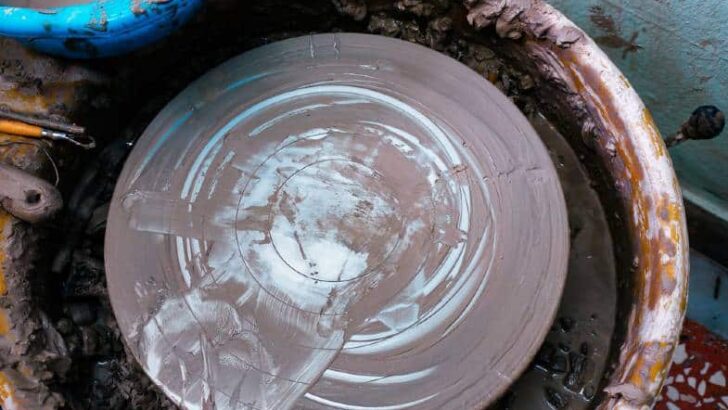The best way to improve your wheel throwing skills is to practice every day. Practicing every day is a lot easier if you have a pottery wheel at home. And buying a used pottery wheel can be a great way to save yourself some money.
Here are some top tips on buying the right used pottery wheel for you…
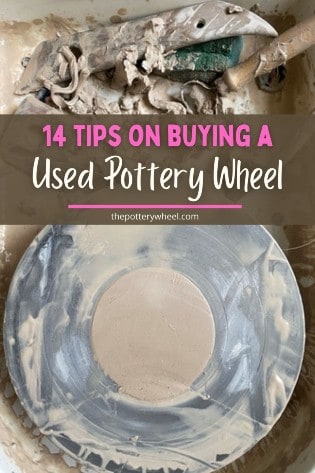
Buying a Used Pottery Wheel
If you want to buy a second-hand wheel, there are a few key things to look out for:
Tip 1 – Understanding the Big Price Range
Used pottery wheels vary in price enormously. You will find that prices will range from around $100 to $1500.
Buying a used pottery wheel is like buying any second-hand item. They vary greatly in age and condition.
Second-hand pottery wheels tend to fall into two groups:
Group 1
The first group is wheels that have been hardly used. These have often been bought by people who want to try pottery as a hobby and then lose interest. A pottery wheel in this category is usually in very good shape with little wear and tear.
This will be reflected in the price tag. Little used pottery wheels generally have a high resale value and will sell for just a bit less than their original price. For example, a wheel that has been used very little and cost $1700 new, can easily sell second-hand for around $1500.
Of course, the sale price will depend on the brand and model of the wheel that is for sale. New pottery wheels range in price from around $200 to $2000. If you want to know more about the cost of buying a new pottery wheel, you can check out my article here.
Group 2
The second group is wheels that have wear and tear and need a bit of attention. These pottery wheels are normally much cheaper than the little-used and abandoned hobby wheel. However, they will probably come with a history that may affect how well they work.
If you are lucky, you might find a used pottery wheel that has a lot of miles on the clock. This wheel might have been well looked after and maintained by its owner and have plenty of life left in it.
Or you might find a wheel that has been sitting in a damp shed getting rusty for a few years.
So, a cheaper used pottery wheel may have been much loved and worked hard, or neglected and underused. Either way, it’s likely that a pottery wheel in this category will need a bit of attention.
Tip 2 – Decide if You Want to buy a ‘Project’
If you are good at DIY and quite technically able, then buying a used pottery wheel that needs work might be a good option for you.
Pottery wheels are relatively simple from a mechanical point of view. So, if you aren’t intimidated by taking a “look under the hood”, then buying a fixer-upper might be a good option.
- You could download a user manual from the manufacturer’s website. User manuals generally include instructions about maintenance.
- Or you could contact the manufacturer directly for advice. Pottery manufacturers and suppliers are usually very helpful and keen to give supportive advice. Even if you did buy their product second-hand!
Tip 3 – Be Quick, a Good Used Pottery Wheel Sells Fast
Good quality second-hand wheels tend to get snapped up pretty quickly if they are priced correctly.
If you notice that a used pottery wheel has been on the market for a while, it may have been priced too high. This might mean that you could make the seller an offer and get a better discount. There is no harm in asking.
Tip 4 – Take a Visit and Give it a Spin
Before you commit to buying a used pottery wheel, it’s very wise to try it out before.
Think of it like buying a car, you wouldn’t buy a used car without taking it out for a drive first. Well, the same is true of buying a pottery wheel.
The following tips outline a few things to look out for when you look over the wheel…
Tip 5 – Check that the Pottery Wheel Runs Smoothly
When the wheel head rotates, how does it sound and feel? A smooth, gentle, consistent humming noise is a good sign.
However, if the wheel makes a crunching, grinding, or squeaking noise, all is not well.
It may be that the main bearing on the shaft of the wheel is corroded. This can be replaced, but replacing bearings is an extra expense.
Noise might also be caused by a worn drive belt which needs to be replaced. Depending on the model of the wheel, you might be able to see the belt underneath.
You may be able to tilt the pottery wheel onto its two back legs and have a look at the belt. This may indicate whether the belt is loose or needs to be replaced.
A griding and crunching can also be a sign of general overall rust and corrosion. So, check the whole wheel for rust and corrosion, particularly the wheel head and shaft.
Tip 6 – How Does it Hold Up When Tested?
It may not be possible for you to actually throw something on the wheel before you buy it. However, what you can do is check how it holds up when it has a bit of pressure applied to the wheel head.
When the wheel head is turning reasonably slowly, try to slow it down with the palms of your hands on the surface.
Or try holding it by the edge of the wheel head and gripping it a bit. Does the wheel head slow down a lot when you do this?
If so, the wheel might be a bit lacking in torque. This would mean that it would not be able to handle centering much clay.
Tip 7 – Check That the Wheel Head Level
The wheel head needs to be level to center your clay. In particular, it’s a good idea to check that the wheel head stays level as it rotates. Does it look like it is waving up and down as it turns? If it undulates, it will be hard to use.
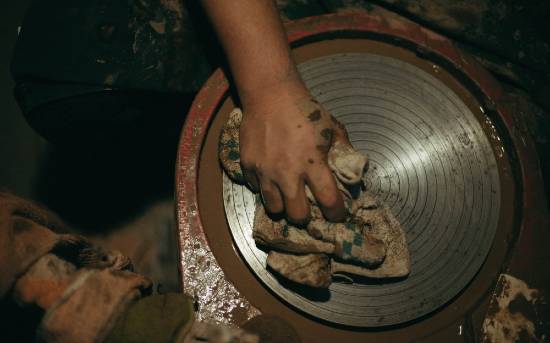
Tip 8 – Check That the Wheel Head Feels Solid
If you apply a bit of pressure to the wheel head does it stay level or does it tilt over a little?
This is important because when you are throwing, you will be applying pressure to your clay. And you don’t want the wheel head to lean as you shape your clay. Again, it would be hard to center your clay on a wobbly wheel head.
Tip 9 – Do the Electrics Look Sound?
Unless you are an electrician, it can be hard to know what you’re looking for when checking over electrics. But do check the obvious electrical components on the wheel, like the power lead and plug.
Do they look in good condition, or are they frayed, burned looking, or crumbling with age?
Changing a power cord on a lead might not be a big job. However, if the external electrics look worn and hazardous, chances are the internal electrics are in a similar condition.
You may be prepared to strip the wheel back down and potentially change the motor. But if this kind of maintenance work doesn’t appeal, then avoid wheels that have worn looking electrical parts.
Tip 10 – How Does the Foot Pedal or (Hand Lever) Feel?
Most electric pottery wheels are controlled by a foot pedal. However, some have a hand lever. Either way, it’s a good idea to check that the speed control functions smoothly.
Does the foot pedal feel responsive and is it easy to control the speed of the wheel smoothly?
Some foot pedals can get very stiff and hard to operate gradually. You might find that the wheel jumps from a slow speed to very fast with very little in between.
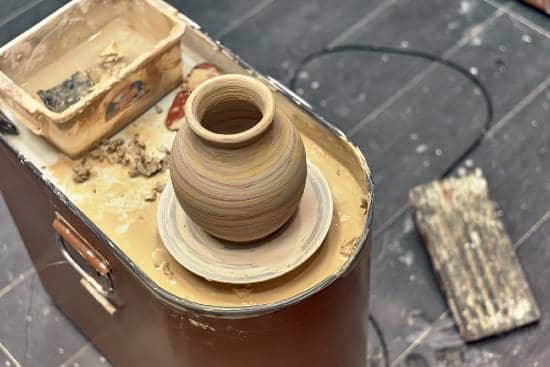
Tip 11 – Be Open-Minded
If you are buying a used pottery wheel, it’s good to be open-minded to different makes and models. And also be open-minded to wheels that are potentially a bit older.
It’s probably unrealistic to have a particular make of pottery wheel in mind and expect to find exactly that wheel in your price bracket.
You might be extremely lucky and find exactly what you are hoping for. However, more important than finding a particular brand or model, is finding a wheel that works well, in your price range.
In addition to this, you need to find a wheel that is close enough to you geographically to be able to transport it back to your home. So, if you find a used pottery wheel that runs well and that is easy to get home, then you are lucky.
Tip 12 – Best Places to Find a Used Pottery Wheel
When looking for a used pottery wheel, the best thing to do is to put out feelers in all directions. Here are some ideas of where you can search, and ask about second-hand pottery wheels for sale…
a) Online Markets:
b) Local Pottery Co-operatives and Organizations
Find out if there are any local pottery co-operatives, contact them and ask if they know of any used pottery wheels for sale. You may be able to pin a notice on their notice board or post a request on their online forum.
c) Public School Auctions
These are auctions where public schools auction off unwanted items. Sometimes equipment that has been used in a school has a lot of wear and tear.
On the other hand, the teachers and technicians at schools often look after their equipment very well. So, you may pick up a good bargain at a school auction.
d) Local Schools or Art/Ceramics Schools
You could actively approach local schools and speak with the art department. Call them or write to them and ask them if they have any used wheels that they are looking to sell. Or ask them if they know anyone who does.
e) Word of Mouth
Let people the people that you come into contact with know that you are looking for a used pottery wheel.
Chances are that someone has a pottery wheel collecting dust in their basement somewhere. You just need to find out who they are and speak with them.
f) Garage Sales
This is a long shot, but it’s worth checking out local garage sales. Now and then you might find a pottery wheel or at least some pottery equipment at a garage sale.
g) Local Pottery Studios
Find out if there are any art or ceramics studios near to you. Go down there, and see if you can chat to anyone who rents a space in the studio.
If they have a notice board in a communal area, you could post a notice on the board.
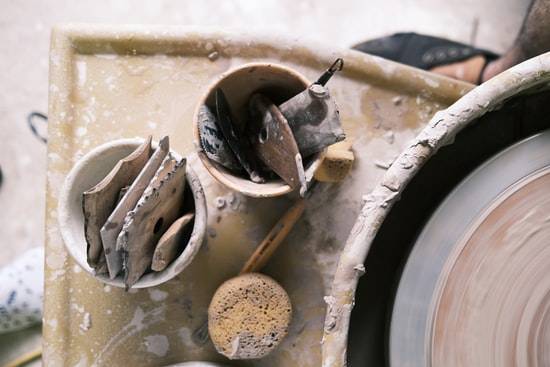
h) A Local Ceramic Supply Store
Local ceramic stores will know potters in your area and will often have an idea of pottery equipment that’s for sale locally.
An example of this is the pottery supplier near me. They have a monthly newsletter that is sent out, which lists used pottery equipment for sale.
i) Estate Sales
This too is a bit of a long shot, but you might find a used pottery wheel in an estate sale. It’s worth trying all avenues.
Tip 13 – Used ‘Potters’ Wheel or Used ‘Pottery’ Wheel
A simple tip that can make a big difference is to do with how you phrase a search online. If you are looking on a site like eBay or Craigslist, try both of the following terms ‘Pottery wheel’ and ‘Potter’s wheel’.
Sometimes listings that show up under one of those phrases do not show up under the other. It’s a simple change, but it might make the difference between a used pottery wheel showing up in the search results or not.
Tip 14 – Maintaining a Used Pottery Wheel
When buying a used pottery wheel, you won’t get a warranty. So, if something goes wrong, you won’t have recourse with the seller.
However, it’s worth thinking about the age of the pottery wheel. Is the wheel a vintage wheel and is the manufacturer still in operation? If it’s an older style wheel and the maker is no longer producing equipment, it may be harder to get parts.
Final Thoughts
It can take a bit of time and work to find a used pottery wheel that is right for you. There are definitely some bargains out there, you just need to find them.
It’s also worth considering whether you want to buy a used pottery wheel or buy a new pottery wheel at the cheaper end of the spectrum. New pottery wheels range widely in prices, and they needn’t cost an arm and a leg.
If you have searched tirelessly to find the right used pottery wheel, and had no luck, you might want to think about buying a new one.
If budget is a key consideration, then you might look into buying a tabletop pottery wheel. These are generally about half the price of a new free-standing pottery wheel. If you want to look into buying a tabletop pottery wheel, check out my article about the Shimpo Aspire and Speedball Artista. This may help you decide if you want to take the plunge and buy a new pottery wheel.
Either way, happy hunting. You may be lucky and find a used pottery wheel that fits the bill quite quickly. But don’t be discouraged if it takes time. Your wheel is out there somewhere, you just need to find it!

